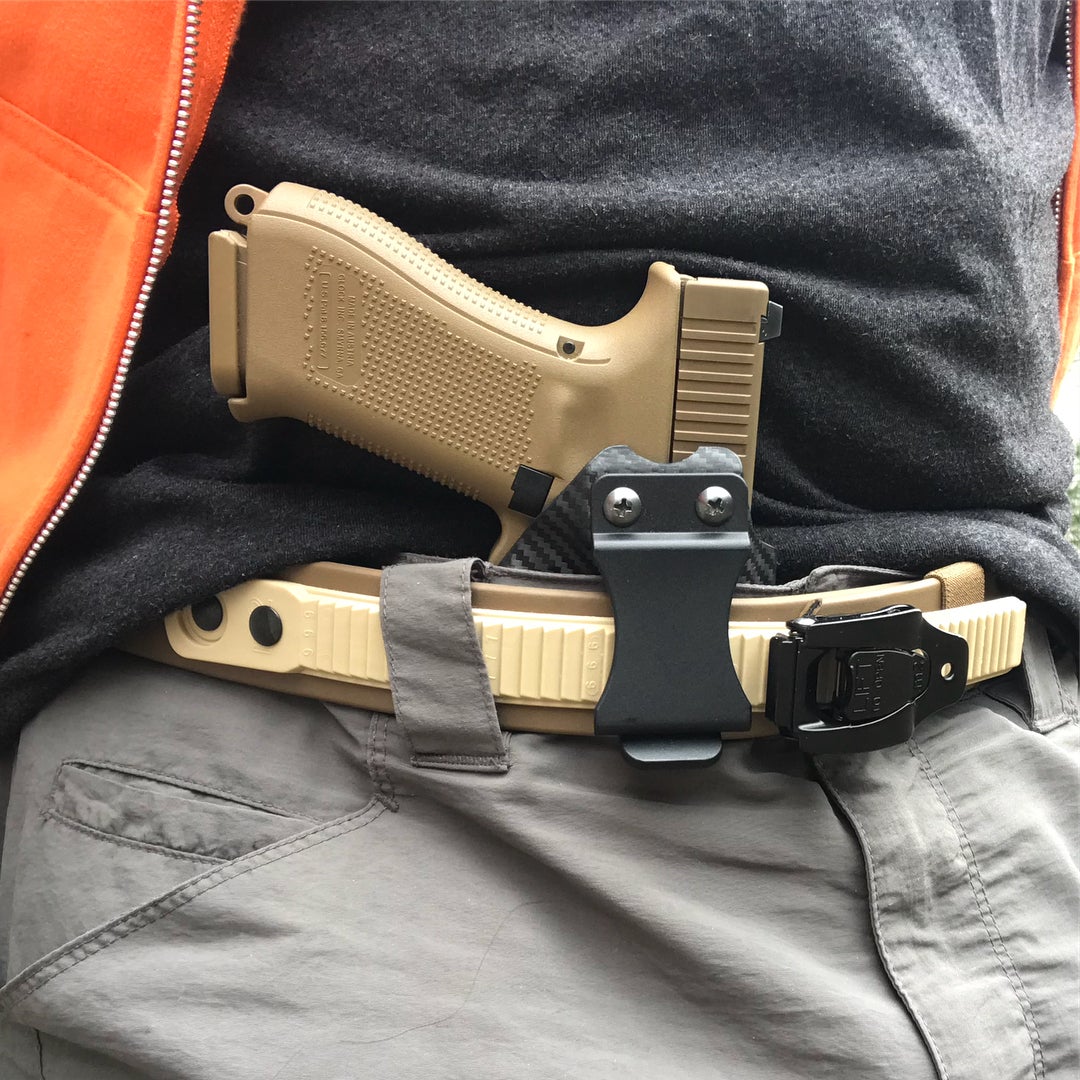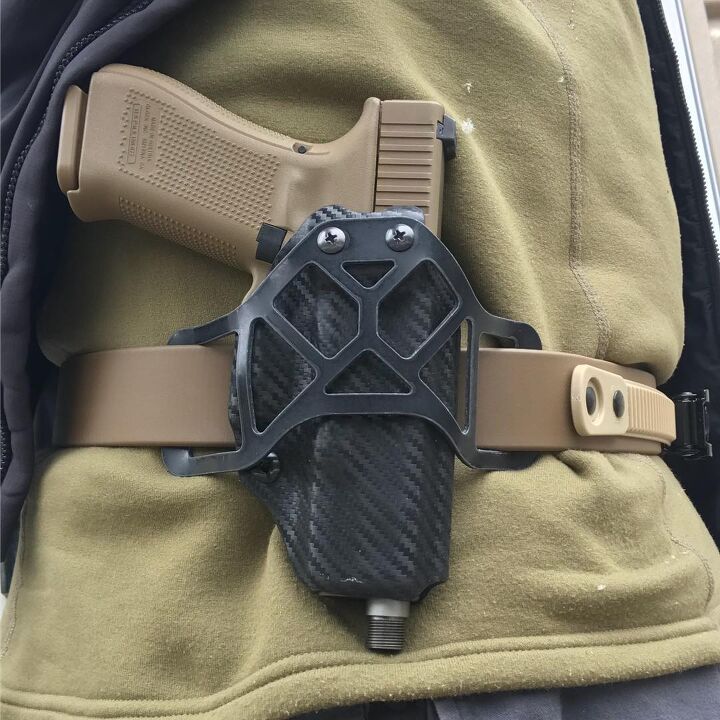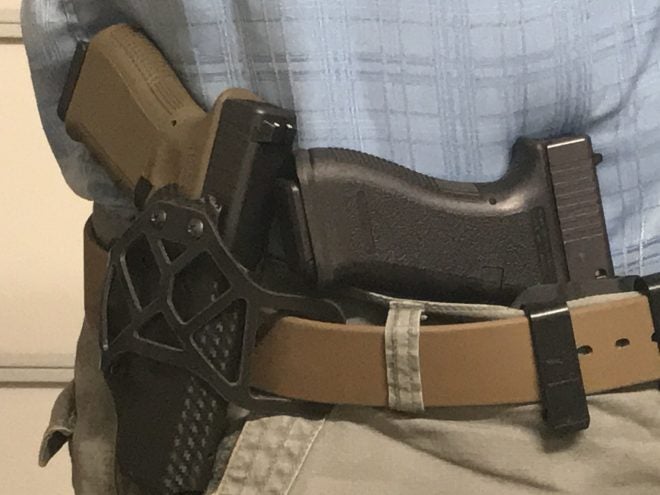Carrying concealed is a responsibility one must be very comfortable with. While the legal ramifications of self defense are for a more lengthy article and discussion, one cannot avoid the importance of comfort when carrying concealed. Often there is a compromise regarding the weather, your body and the clothes you wear.
Concealed Carry Corner: Holster Hokey Pokey – Inside Or Outside?
For most people carrying concealed they wear a holster on their waist band with a good kydex holster. But how and where do you wear it? Inside waistband or outside waistband? This comes down to comfort for a majority of people with weather playing a big part of the decision making process. For people who live in areas with real weather fluctuations, you can find yourself carrying in extreme heat as well as sub zero temperatures depending on time of the year. Lets explore this problem.
Hot Weather – Inside Carry
Carrying outside the waistband becomes challenging in hot weather simply because you don’t have long garments to cover your concealed carry handgun. Most people adopt inside waistband for this reason. A simple t-shirt or button down shirt will work perfectly to conceal your gun. Of course you could carry outside waistband if you wore a vest like an IDPA shooter but that does look a bit suspicious. How often do you see people wearing fishing vests all the time outside of a fishing town during fishing season?

photo by Terrance Rod & Gun
So that leaves carrying inside the waistband; and there are some things that help. One device that has greatly helped IWB carry is the holster claw. The claw is a small piece of plastic that extends away from the trigger guard.

Photo by BSD Holsters
When the holster is worn, your belt lays across the claw. This acts like a lever when the belt applies pressure against it. This twists the holster a bit and tucks the butt of the grip closer to your stomach. Thus avoiding the dreaded “printing” or showing the silhouette of your gun through your shirt.
Immediate access to your firearm in a crisis situation is crucial and carrying inside waistband is probably a necessity when wearing less clothing. However, the added comfort does come at a cost. Or the opposite can be true: often you lose comfort for the sake of concealment.
Cold Weather – Outside Carry
If you live in a region that experiences cold temperatures, wearing additional layers is unavoidable, including an outer garment like a jacket. This complicates access to your firearm and you will need to consider how you will get to your firearm in an emergency. Here outside waistband may make access easier since you do not have to peel back as many layers of clothes to get to your firearm like if you were carrying inside waistband. With carrying outside the waistband you have more options and can typically carry a larger pistol without sacrificing comfort.
The major thing to think about here is what jacket do you wear? Depending on how cold it is, like sub zero temperatures, you may be forced to button or zip up your jacket. Now this complicates access to your firearm. Some companies design outerwear with this in mind. Some jackets have a split built into the sides held with a snap, velcro or zippers. So all you need to do is split the side and have immediate access to your handgun.
Holster Choices
Since you may have to deal with multiple temperature zones throughout the year you will probably need to get multiple holsters. In some cases, companies have holster designs that can be transformed from inside to outside waistband. The UM Tactical Qualifier holster has a unique design that allows it to function both ways.
The Qualifier holster has a stereotypical over-the-belt clip design for carrying inside waistband.

The Qualifier strap is a clever device that replaces the belt clip and acts as belt loops, transforming the Qualifier into an outside the waistband holster.

The only downside to the Qualifier is that it does not have a claw for its IWB carry mode and tools are required to transform it to OWB carry.
Remember, you should choose a holster that fits your needs. If you are carrying concealed for long periods of time you should feel comfortable doing so. Sure there will be some compromises, but one aspect you should not sacrifice is safety. You should not use a holster that might not be as safe as others just because it is more comfortable.
Holster Features
A good holster should protect the trigger from being manipulated while holstered. Some holsters have been known to facilitate problems. Holsters like the Serpa, when used as intended and designed does work, but there have been many examples where the index finger release mechanism has malfunctioned, locking the gun into the holster. Or worse, shooters rush getting their gun out and have applied too much force on the release mechanism causing them to flex their index finger. This leads to a finger that falls into the trigger guard, pulling the trigger.
Your holster should have a solid method of attaching to your belt. And you should use a belt with a rigid reinforcement. Ideally your belt creates a solid platform for you to mount your holster. Your dress leather belt is not a good platform. Sometimes the weight and size of the holster can stretch softer belts out of shape causing the holster to sag. Having a solid platform and a properly mounted holster will give you more consistency. That way if you need to draw your pistol, it will always be in the same position. You should not have to hunt for your gun. Another benefit to a solid belt platform and holster is to retain your pistol so it does not accidentally fall out if you happen to be inverted or some other uncommon position other than vertical.
Conclusion
Weather can dictate the clothes you wear and you need to think about how to carry your concealed handgun. Access to the firearm and comfort are often sacrificed for the sake of concealment. Choosing an appropriate holster requires one to take into account all of these issues. What you are wearing and how you wear your holster have a symbiotic and in some cases a parasitic relationship. You can end up playing holster “hokey pokey” having holsters inside or outside waistband. Big jackets allow for larger pistols and bulkier holsters. Where as warmer weather leaves you typically wearing less clothing requiring one to make compromises to comfort. Make sure you choose a good holster that secures the handgun and that it is mounted on a solid platform using a good belt for concealed carry.
TFB’s Concealed Carry Corner is brought to you by GLOCK

 Your Privacy Choices
Your Privacy Choices
